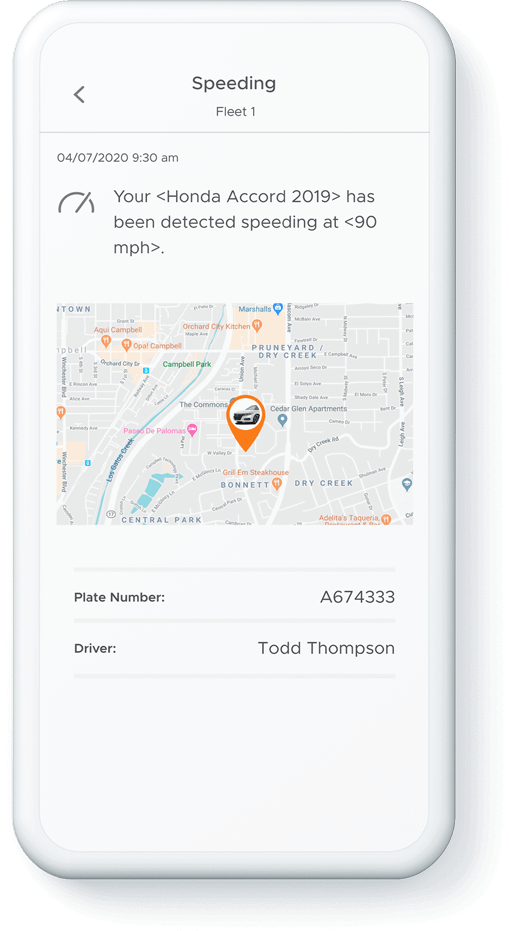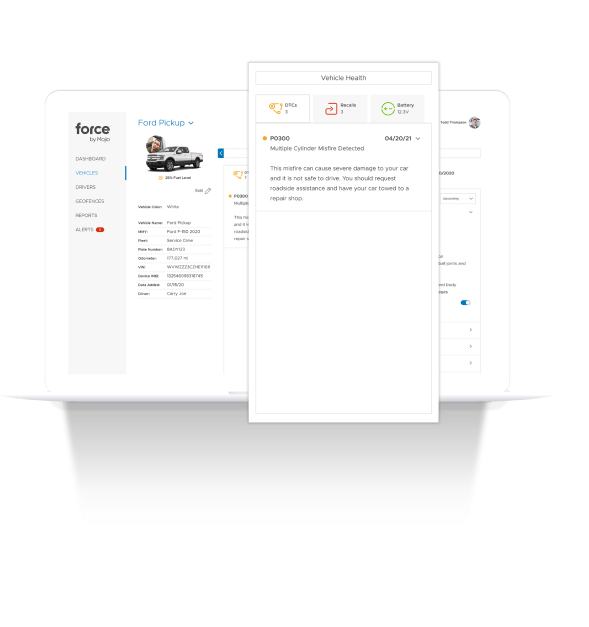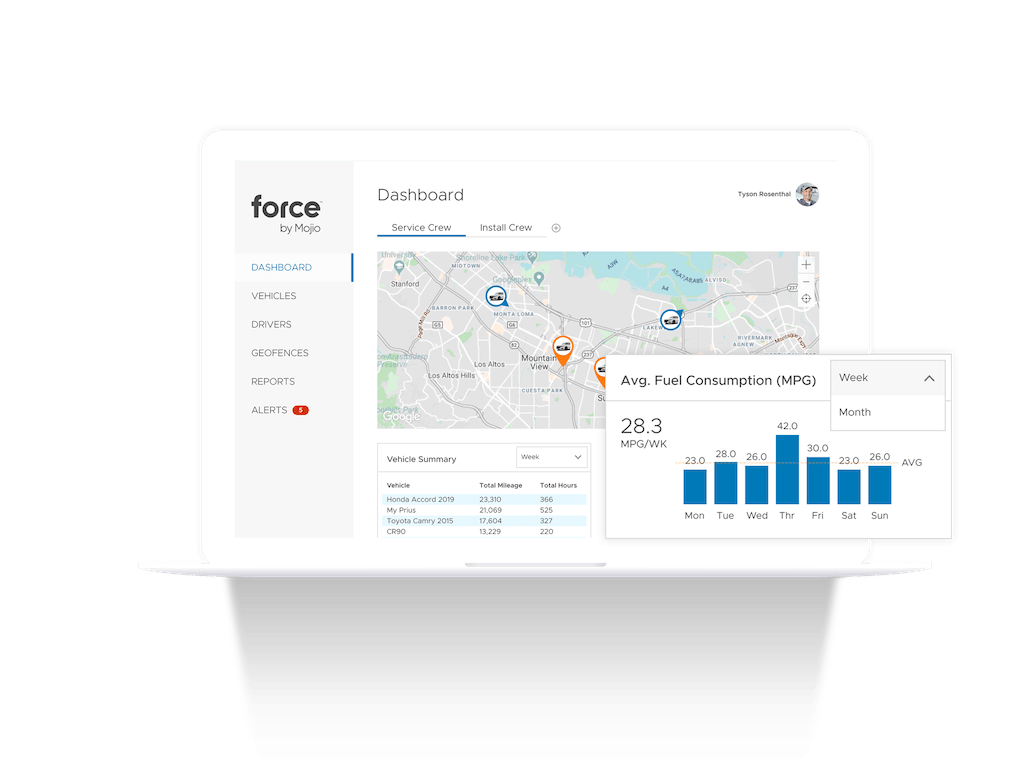One of the most consistent expenses for small businesses is also one of the most easily mitigable–fuel costs. Whether your fleet has 2 vehicles or 20, the costs associated with keeping them fueled and on the road can add up quickly. Luckily for small business owners, with Force Fleet Tracking’s fleet tracking software, reducing fleet fuel costs is one of the first quick wins you’ll see when you start tracking your vehicles.
This article will help you understand how to increase your fleet’s fuel efficiency and the Force Fleet Tracking tools that will directly impact your small business’ bottom line.
What is fleet fuel efficiency?
Your fleet fuel efficiency is the gas mileage per gallon that your drivers and vehicles are getting within a set time frame across your fleet. There are several key metrics that impact and influence your fleet fuel economy, including fuel consumption (the amount of fuel used by each vehicle within a set time frame), idling waste, and engine runtime.
Small business owners tend to accept that fuel costs are just a standard cost of doing business, but once you have visibility into driver behavior and the way your vehicles are being driven, these costs can be monitored and managed.
How do I increase my fleet fuel efficiency?
The easy answer is to invest in a fleet tracking solution like Force. When a fleet management system like Force is deployed, one of the quick wins for business owners is the improvements they see in fuel efficiency and cost reduction.
The longer answer is that there are many factors that play into making your fleet more fuel efficient. Driving with lighter loads, improving fleet efficiency when it comes to routing, keeping tires properly inflated, using cruise control, monitoring fleet drivers’ behaviors and costly bad habits, and monitoring gas mileage are all ways to reduce your fleet’s fuel usage.
These tactics may seem difficult to monitor and manage when you have a fleet of drivers who might not be sharing every detail of their day spent in your vehicles with you. So, how do small business owners identify areas for improvement and fuel savings when they can’t be in the car themselves?
How Force helps reduce fleet fuel costs
GPS fleet tracking solutions are the key to saving fuel at scale. These are the tools and features in the Force tracking system that will help you embrace fuel efficient practices and reduce fuel spending across your fleet:
1. Idling reports help reduce fuel expenses
Idling is a stealth killer of bottom line benefits. While it may seem innocuous, it takes less than a minute of idling to waste more fuel than you would if you stopped and restarted the engine. Contrary to popular belief, it also causes more wear and tear to your engine to idle it than restart it, so the fuel costs are compounded with future maintenance costs. And without a way to track idling across your fleet, you’ll be in the dark about how much idling is taking place, and how much it’s costing you.

With Force Fleet Tracking’s idling reports, you’ll have all the data you need to easily identify excessive and unnecessary idling and correct this type of driver behavior. This empowers business owners to correct expensive driver habits and reduce idling (and the costs associated with it.)
Find out how much Force could save your business on fuel costs with idling waste prevention alone.
Curbing idling leads to big fuel cost savings for small business
Cutting idling time cuts fuel costs, and Force customers see the benefits of idling reports right away. Alta Arizona’s Phoenix-area fleet of 9 trucks began monitoring idling time with Force in April of 2022. By December 2022, they went from 41% idle time to only 11%. This single fleet saved more than $3,739.20 per year in fuel costs off of that one metric.
“We’re thrilled with the savings,” says one Senior Project Manager at Alta Arizona. “Force Fleet Tracking’s Idling Reports give us exactly the right info, in a dashboard that makes it easy to manage by driver. We could not have reduced idling times so well without this.”
Our pricing is like our product: designed for small businesses. Find out how little it costs to save big.
2. Better dispatching means better fuel and route efficiency
GPS tracking enables better dispatching, but how does that impact your fuel costs? Essentially, having a real-time bird’s eye view of all of your vehicles means that you can choose the most efficient routes and send the closest driver, reducing travel time, and preventing drivers from potentially ‘taking the scenic route.’ Getting technicians to job sites faster does more than get the job done faster; route efficiency directly correlates to saved time and money. Less time driving means less money spent on fuel.

Force’s GPS fleet tracking features also help you cut down on administrative costs due to manual tracking, and wasted time texting or calling technicians to figure out where they are. Stop wondering which driver is closest to the job and reduce your fuel costs dramatically.
3. Driver behavior reports lower fuel costs
When safety comes first, fuel cost savings soon follow. Things like aggressive acceleration and speeding, aggressive driving practices like harsh cornering and braking, and time spent over the speed limit all impact your fleet’s fuel consumption. For example, something as simple as driving at slower speeds of 65 mph on the highway instead of 75 mph can cut fuel consumption by up to 20%.

How your drivers operate your vehicles directly impacts your operating costs and how much fuel is wasted. And with gas prices as unpredictable as they are, not many small businesses can afford to waste fuel.
Poor driver behavior can also lead to higher fuel and maintenance costs, costly incidents and accidents on the road, not to mention a bad brand reputation. Force’s driver RoadScores helps you better manage your drivers and the way they operate your vehicles.
Force’s driver behavior features notify you of the exact time and place any unsafe and expensive driving events took place such as harsh acceleration, cornering, or braking, excessive speed, and more. It’s no surprise that people perform better when they know they’re being observed. This is no exception for your drivers.
4. Save money with vehicle health and maintenance reports
Vehicle health monitoring and predictive maintenance scheduling not only help reduce your overall maintenance costs and avoid downtime due to unexpected maintenance or repairs, it can help you curb the maintenance issues that drive up your fuel consumption.

Force’s vehicle health and maintenance software monitors for battery health, fuel levels, factory recalls, and diagnostic trouble codes (DTCs), then breaks the issues down into plain English for you to easily understand what’s wrong. Some common maintenance issues like low tire pressure, check engine lights, and DTC codes can have a huge negative impact on your fuel efficiency, but might be ignored by drivers.
Drivers may see a light go on and fail to report it, but with Force, the manager gets immediate awareness of these vehicle performance issues so that they can improve fuel efficiency and lower costs. Force gives you a complete picture of each vehicle’s health and alerts you as soon as one of them needs attention.
5. Geofencing for after hours vehicle monitoring
Most companies have a gap in visibility on how company vehicles are being used after hours and on weekends. Force helps you manage off-hours costs with highly customizable geofences (virtual boundaries).

Force’s geofences aren’t limited to a simple circle radius. Instead, you can create custom shaped geofences to fit your business’ needs. You can also configure them to particular time frames, meaning you can be notified when any of your vehicles enter or exit an area after hours or on the weekend. This kind of visibility means you’ll be alerted if anyone takes your truck on an unauthorized out-of-town trip.
6. Fuel consumption reports for fuel management across fleets
It might seem simple but monitoring your fuel usage is one of the easiest ways to save money. Force’s fuel consumption dashboards alert you if one of your vehicles is critically low on fuel, and also help you improve fuel economy by flagging driver behaviors that could be costing you up to 40% more than necessary.

Cut down on fleet costs by identifying and addressing wasteful, and sometimes dangerous, driving habits like idling, aggressive driving, and inefficient routing.
Reduce costs and improve your fleet’s fuel efficiency with Force
Greater data means greater business decisions. That’s why Force provides unparalleled visibility into driver habits, vehicle performance, routing and dispatching, idling time, and fuel consumption across your entire operation–to give small business owners access to big business insight through easy-to-understand dashboards and diagnostics.
With this information, small business owners can work with their drivers and data to reduce fleet fuel costs and feel the Force difference immediately, saving thousands of dollars annually for just $20 per vehicle per month.